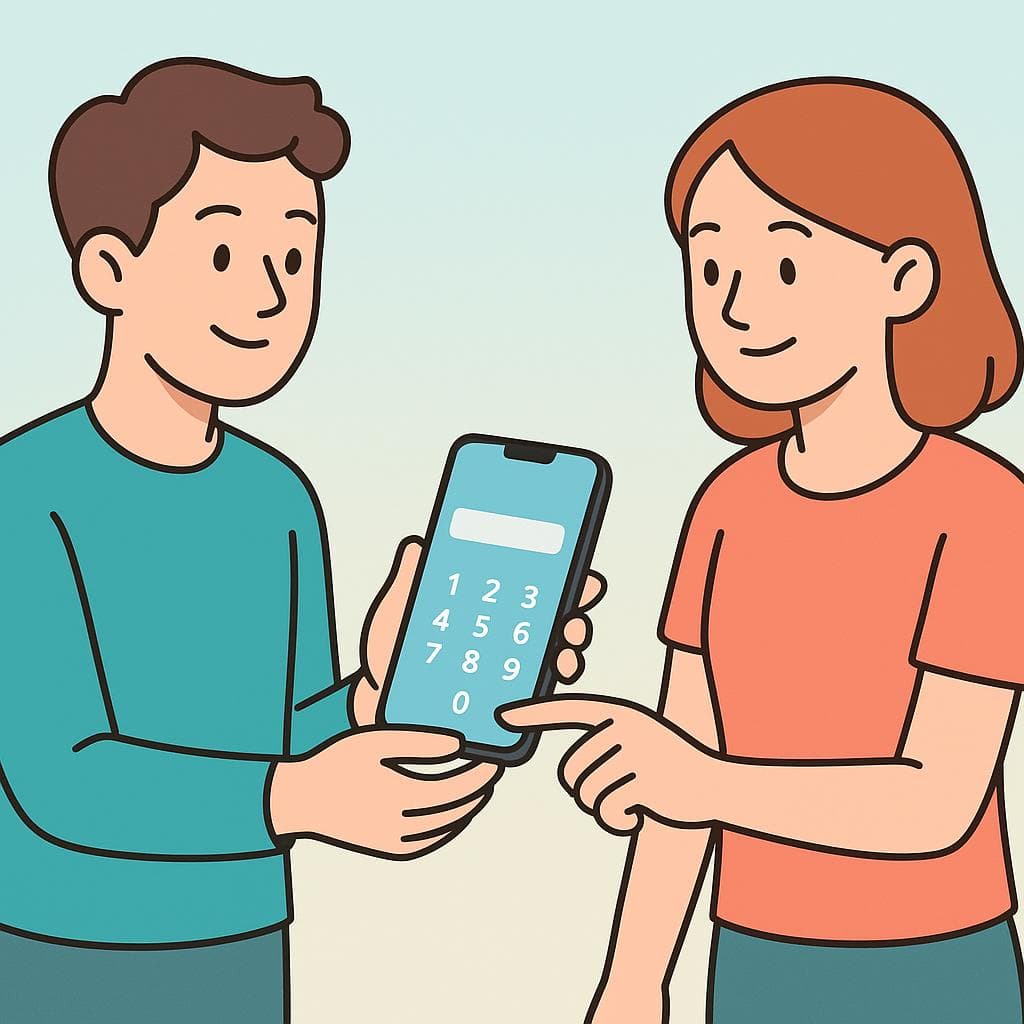What is your phone number?
in Spanish¿Cuál es tu número de teléfono?
/kwahl ess too NOO-meh-roh deh teh-LEH-foh-noh/
This is the most common and direct way to ask for someone's phone number informally. It uses 'tu' (your), which is perfect for friends, peers, or people your age.

Exchanging numbers is a key part of making new friends or contacts. Knowing how to ask is essential!
💬Other Ways to Say It
¿Cuál es su número de teléfono?
/kwahl ess soo NOO-meh-roh deh teh-LEH-foh-noh/
This is the formal version of the main phrase, using 'su' instead of 'tu'. It's the polite and respectful way to ask someone you don't know, an older person, or someone in a professional setting.
¿Me das tu número?
/meh dahs too NOO-meh-roh/
A very common and slightly more casual way to ask, translating to 'Can you give me your number?'. It feels a bit softer and more conversational than the direct 'What is...?' question.
¿Me puede dar su número?
/meh PWEH-deh dahr soo NOO-meh-roh/
This is the polite, formal version of 'Can you give me your number?'. Using 'puede' and 'su' makes it respectful and suitable for almost any formal interaction.
¿Cuál es tu móvil?
/kwahl ess too MOH-veel/
In Spain, 'móvil' is the standard word for a mobile/cell phone. This is the go-to phrase you'll hear and use there.
¿Cuál es tu celular?
/kwahl ess too seh-loo-LAHR/
Throughout Latin America, 'celular' (or 'cel' for short) is the most common word for a cell phone. This is the equivalent of asking for someone's 'móvil' in Spain.
¿Me pasas tu contacto/WhatsApp?
/meh PAH-sahs too kohn-TAHK-toh / whats-APP/
A modern and very common alternative that means 'Can you send me your contact info/WhatsApp?'. Since WhatsApp is tied to a phone number, this achieves the same goal in a very natural way.
🔑Key Words
Key Words to learn:
📊Quick Comparison
Choosing the right way to ask depends heavily on formality and context. Here’s a quick guide to the most common options.
| Phrase | Formality | Best For | Avoid When |
|---|---|---|---|
| ¿Cuál es tu número de teléfono? | Informal | Friends, classmates, and people your own age. | Speaking to your boss, an elderly person, or a new client. |
| ¿Cuál es su número de teléfono? | Formal | Professional settings, showing respect, or with strangers. | Chatting with close friends, as it can sound a bit stiff. |
| ¿Me das tu número? | Casual | Social situations where you feel a friendly connection. | Formal or professional contexts where it's too direct. |
| ¿Me puede dar su número? | Polite / Formal | Asking for information politely from service staff or officials. | Hanging out with buddies, where it's unnecessarily formal. |
📈Difficulty Level
The sounds are mostly straightforward for English speakers. The word 'teléfono' has four syllables, but each is pronounced exactly as it looks.
The main grammatical hurdles are knowing to use 'cuál' instead of 'qué' and choosing correctly between the informal 'tu' and the formal 'su'.
Understanding when to be direct versus indirect, and the high importance of formality ('tu' vs. 'su'), requires some cultural awareness.
Key Challenges:
- Choosing between 'cuál' and 'qué'
- Using 'tu' vs. 'su' correctly in different social contexts
- Remembering the regional words: 'móvil' vs. 'celular'
💡Examples in Action
¡Qué bien me caíste! ¿Cuál es tu número de teléfono para que sigamos en contacto?
I really liked you! What's your phone number so we can stay in touch?
Disculpe, señor, ¿me puede dar su número para confirmar la cita mañana?
Excuse me, sir, can you give me your number to confirm the appointment tomorrow?
Oye, se me va a morir la batería. Pásame tu celular rápido antes de que se apague.
Hey, my battery is about to die. Give me your cell number quick before it turns off.
Para completar su registro, necesito su nombre completo y su número de teléfono, por favor.
To complete your registration, I need your full name and your phone number, please.
🌍Cultural Context
WhatsApp is King
In most of the Spanish-speaking world, asking for a phone number is essentially asking for someone's WhatsApp. It's the primary mode of communication. Don't be surprised if someone asks, '¿Tienes WhatsApp?' instead of asking for your number directly.
The Indirect Approach
While asking directly is fine, a softer, common strategy is to offer your number first. Saying something like 'Te doy mi número y me escribes cuando puedas' ('I'll give you my number and you can text me when you can') puts the ball in their court and can feel less demanding.
Formality Matters
The distinction between 'tu' (informal) and 'su' (formal) is culturally important. Using 'tu' with an authority figure or an elderly person can be seen as disrespectful. When in doubt, starting with the formal 'su' is always the safer and more polite option.
Saying the Numbers
When someone gives you their number, they might say it as single digits ('seis, uno, siete...') or group them in pairs ('sesenta y uno, setenta...'). Be prepared to hear it either way! It's also common to say 'cero' for zero, not 'oh' like in English.
❌ Common Pitfalls
Using 'Qué' instead of 'Cuál'
Mistake: "¿Qué es tu número de teléfono?"
Correction: ¿Cuál es tu número de teléfono?
Mixing Up 'Tu' and 'Su'
Mistake: "Asking your new boss: '¿Cuál es tu número?'"
Correction: Asking your new boss: '¿Cuál es su número?'
Forgetting the Word for 'Phone'
Mistake: "Just asking, '¿Cuál es tu número?'"
Correction: '¿Cuál es tu número de teléfono/móvil/celular?'
💡Pro Tips
Confirm the Number
After they tell you their number, it's a great idea to repeat it back to them to make sure you got it right. You can say, 'A ver, es el...' ('Let's see, it's...') and then say the number. This avoids future communication mishaps.
Send a Test Message
A very common and friendly thing to do right after getting someone's number is to send them a quick WhatsApp message like, 'Hola, soy [Your Name]. Ya tienes mi número.' ('Hi, it's [Your Name]. Now you have my number.'). This confirms the number works and saves your contact in their phone.
Listen for 'Cel' or 'Fono'
In casual conversation, you'll often hear shortened versions of the words for phone. People in Latin America might say 'cel' instead of 'celular', and in some places like Chile, 'fono' is a common short version of 'teléfono'.
🗺️Regional Variations
Spain
The word 'móvil' is overwhelmingly dominant for 'cell phone.' Using 'celular' will mark you as a foreigner or someone who learned Spanish elsewhere, though you'll be understood.
Mexico
Both 'celular' and 'teléfono' are very common. It's also very common to ask for someone's 'WhatsApp' directly. The prefix for Mexican numbers (+52) is important when exchanging with foreigners.
Argentina & Uruguay
The use of 'vos' instead of 'tú' is standard, which changes the verb. So instead of '¿Me das...?', you'll hear '¿Me das...?' (same spelling, different conjugation context) and instead of '¿Tienes...?' you'll hear '¿Tenés...?'.
Caribbean (e.g., Cuba, Puerto Rico, Dominican Republic)
The language is very fluid and fast. Direct requests like 'Dame tu número' ('Give me your number') can be common in casual contexts and don't sound as abrupt as they might in English.
💬What Comes Next?
After you ask for their number
Claro, es el 612 345 678.
Of course, it's 612 345 678.
Gracias. Ahora te mando un mensaje para que tengas el mío.
Thanks. I'll send you a message now so you have mine.
They give you their number and want to confirm
¿Lo apuntaste?
Did you write it down?
Sí, ya lo guardé en mis contactos. ¡Gracias!
Yes, I just saved it in my contacts. Thanks!
You want to offer your number first
¡Dale, perfecto!
Go for it, perfect!
Si quieres, te doy mi número.
If you want, I can give you my number.
🧠Memory Tricks
This links the English word 'call' with the sound of the correct Spanish word 'cuál', reinforcing the right choice for this specific question.
🔄How It Differs from English
The biggest difference is that Spanish distinguishes between 'qué' (what) and 'cuál' (which/what), where English just uses 'what'. For asking for specific information like a name or number, Spanish prefers 'cuál'. Another key difference is the built-in formality; English relies on tone and extra words ('could you please'), while Spanish uses different pronouns ('tu' vs. 'su') and verb forms to show respect.
🎯Your Learning Path
➡️ Learn Next:
How to give your phone number
This is the natural answer to the question you just learned to ask.
Do you have WhatsApp?
A very common and modern alternative to asking for a phone number directly.
Can I call you later?
It's the logical next step after getting someone's number.
What is your email address?
Expands your ability to ask for different types of contact information, especially in professional settings.
✏️Test Your Knowledge
💡 Quick Quiz: What is your phone number?
Question 1 of 3
You're at a business conference and need to get the contact info of a potential client, an older gentleman. How do you politely ask for his number?
Frequently Asked Questions
Why do you use 'cuál' instead of 'qué' to ask for a phone number?
Think of 'cuál' as meaning 'which one?' and 'qué' as meaning 'what?' in a definitional sense. When you ask for a phone number, you're asking for 'which one' out of all the possible numbers that belongs to that person. It's a request for specific data, which is a classic use case for 'cuál' with the verb 'ser'.
What's the real difference between 'teléfono', 'móvil', and 'celular'?
'Teléfono' is a general term for any phone, including a landline. 'Móvil' is what you'll almost exclusively hear in Spain for a mobile/cell phone. 'Celular' is the standard term for a cell phone throughout Latin America. Using the right one will make you sound more like a local!
How do I know whether to use the informal 'tu' or the formal 'su'?
It's a great question! Use 'tu' with people you know well, friends, family, children, and people your own age in casual settings. Use 'su' for people you don't know, older people, authority figures (like police or bosses), and in any professional or formal setting. When in doubt, starting with 'su' is always the safest and most polite choice.
Is it considered rude to ask for someone's number directly in Spanish-speaking cultures?
Not necessarily rude, but context is everything. In a business setting, it's normal. In a social setting, it can feel a bit forward depending on the situation. That's why softer approaches like asking '¿Tienes WhatsApp?' or offering your number first ('Te doy mi número') are very popular alternatives.
How do I say my own phone number in Spanish?
It's easy! Just say 'Mi número es...' followed by the digits. You can say them one-by-one (e.g., 'seis, uno, dos...') or in pairs ('sesenta y uno, veinte...'). For zero, always use 'cero'.
What if I just want their WhatsApp?
You can be direct! Asking '¿Tienes WhatsApp?' (Do you have WhatsApp?) or '¿Me pasas tu WhatsApp?' (Can you give me your WhatsApp?) is extremely common and natural. It's often the preferred way to ask to stay in touch.
📚Continue Learning Spanish Phrases
Explore More Phrases in These Categories
Find similar phrases to expand your Spanish vocabulary:
Want to Learn More Spanish Phrases?
Browse our complete collection of Spanish phrases organized by situation, from basic greetings to advanced conversations. Perfect for travelers, students, and anyone learning Spanish.
View All Spanish Phrases →




